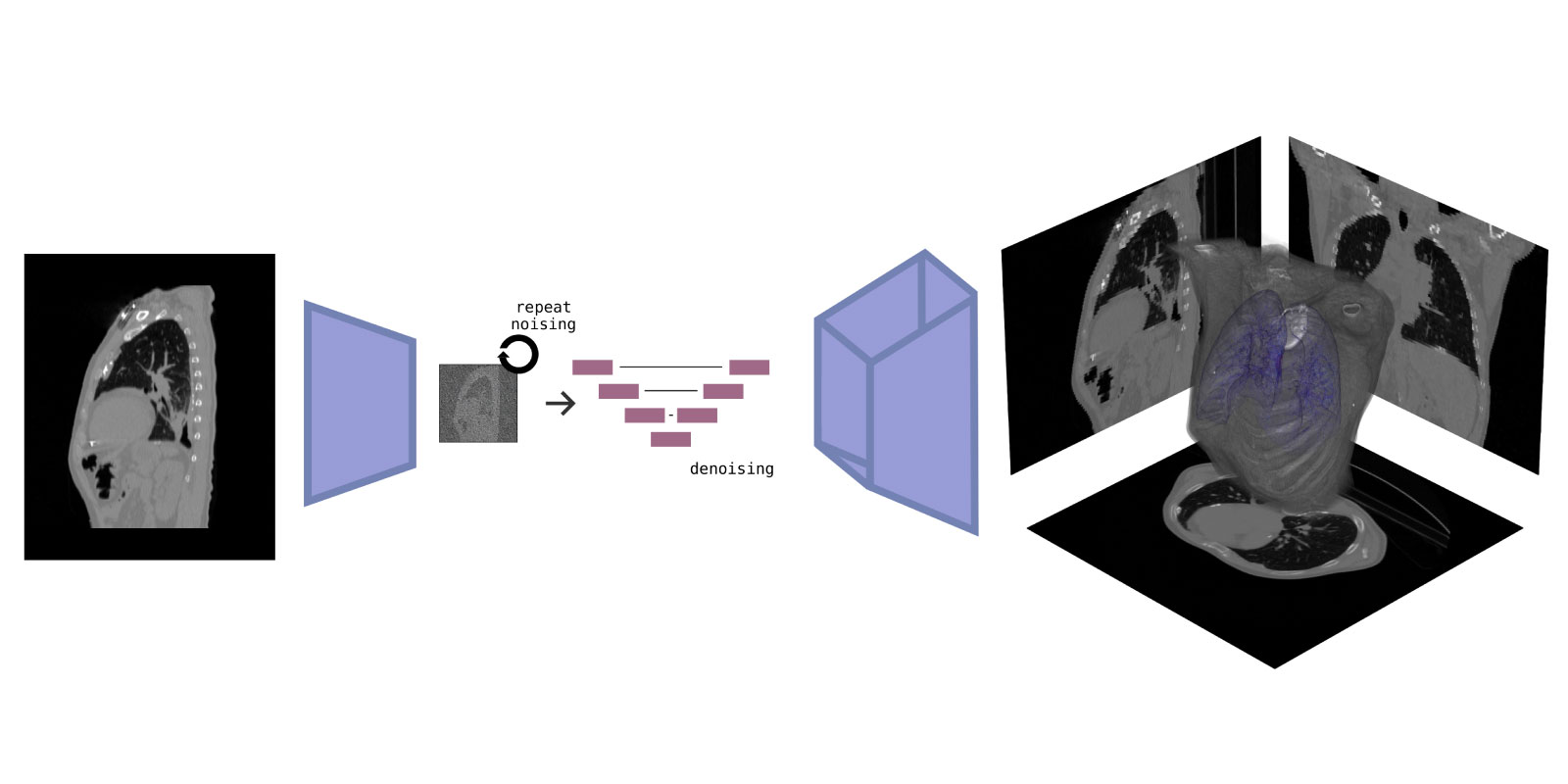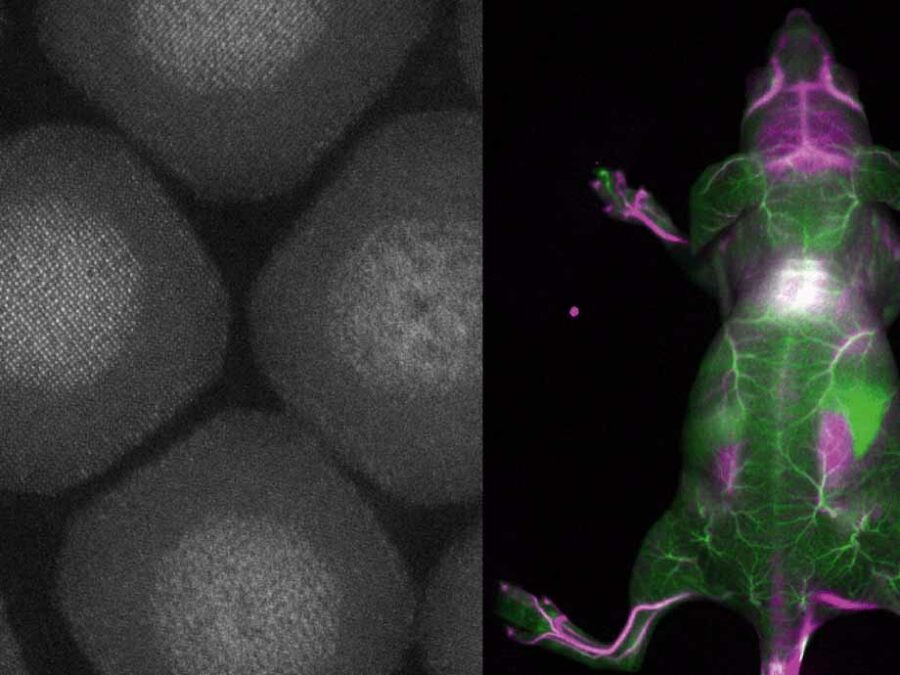The integration of 2D cine-MR imaging in lung cancer radiation therapy has significantly improved treatment of moving targets, allowing for reduced safety margins and dose escalation. This approach has led to better overall survival rates for lung cancer patients. However, available tracking methods do not account for the full range of anatomical trajectories during breathing, missing out-of-plane motions of critical structures. This limitation makes current gating techniques insufficient for tumors located near the hilar or mediastinal regions, where dose escalation would result in irradiation of adjacent moving aortico-pulmonary structures, causing unacceptable toxicity.
To safely escalate doses in ultra-central lung tumors, fast image vision and generative extrapolation beyond integrated MR imaging is essential.
Detecting of out-of-plane moving organs at risk in the high-dose area would allow triggering of an irradiation interlock in the clinical gating scenario. However, this detection has to be robust, artifact-resistant, and fast. Within this project, we aim to develop novel algorithms to detect subtle movements in 2D cine scans. This will help recognize out-of-frame organ movements, improving the accuracy of radiation doses to cancerous tissue while sparing critical organs.
Long-term, improving 2D temporal anomaly detection is insufficient. Advances in MR-guided particle therapy, where the interplay effect between motion and beam scanning causes more severe dosimetric consequences, require full 4D motion information. Dose computation and re-optimization need full beam path anatomy estimates. As real-time 4D imaging is not feasible, we will advance existing generative AI algorithms to three dimensions, allowing volumetric anatomy extrapolation and continuous tumor motion tracking.
Publications
4725570
CLARITY
1
https://helmholtz-imaging.de/apa-bold-title.csl
50
date
desc
3987
https://helmholtz-imaging.de/wp-content/plugins/zotpress/
%7B%22status%22%3A%22success%22%2C%22updateneeded%22%3Afalse%2C%22instance%22%3Afalse%2C%22meta%22%3A%7B%22request_last%22%3A0%2C%22request_next%22%3A0%2C%22used_cache%22%3Atrue%7D%2C%22data%22%3A%5B%7B%22key%22%3A%226THQPFVZ%22%2C%22library%22%3A%7B%22id%22%3A4725570%7D%2C%22meta%22%3A%7B%22creatorSummary%22%3A%22Th%5Cu00fcrw%5Cu00e4chter%22%2C%22parsedDate%22%3A%222024%22%2C%22numChildren%22%3A1%7D%2C%22bib%22%3A%22%26lt%3Bdiv%20class%3D%26quot%3Bcsl-bib-body%26quot%3B%20style%3D%26quot%3Bline-height%3A%201.35%3B%20padding-left%3A%201em%3B%20text-indent%3A-1em%3B%26quot%3B%26gt%3B%5Cn%20%20%26lt%3Bdiv%20class%3D%26quot%3Bcsl-entry%26quot%3B%26gt%3BTh%26%23xFC%3Brw%26%23xE4%3Bchter%2C%20S.%20K.%20%282024%29.%20%26lt%3Bi%26gt%3B%26lt%3Bb%26gt%3B%26lt%3Bspan%20style%3D%26quot%3Bfont-style%3Anormal%3B%26quot%3B%26gt%3BDevelopment%20of%20a%20software%20concept%20and%20algorithmic%20components%20for%20automating%20the%20generation%20of%20an%20articulated%20patient%20model%20based%20on%20radiation%20treatment%20planning%20CT%20scans%26lt%3B%5C%2Fspan%26gt%3B%26lt%3B%5C%2Fb%26gt%3B%26lt%3B%5C%2Fi%26gt%3B%20%5BBachelorarbeit%2C%20Hochschule%20Heilbronn%20%26amp%3Bamp%3B%20Universit%26%23xE4%3Bt%20Heidelberg%2C%202024%5D.%20%26lt%3Ba%20class%3D%26%23039%3Bzp-ItemURL%26%23039%3B%20href%3D%26%23039%3Bhttps%3A%5C%2F%5C%2Finrepo02.dkfz.de%5C%2Frecord%5C%2F293939%26%23039%3B%26gt%3Bhttps%3A%5C%2F%5C%2Finrepo02.dkfz.de%5C%2Frecord%5C%2F293939%26lt%3B%5C%2Fa%26gt%3B%26lt%3B%5C%2Fdiv%26gt%3B%5Cn%26lt%3B%5C%2Fdiv%26gt%3B%22%2C%22data%22%3A%7B%22itemType%22%3A%22thesis%22%2C%22title%22%3A%22Development%20of%20a%20software%20concept%20and%20algorithmic%20components%20for%20automating%20the%20generation%20of%20an%20articulated%20patient%20model%20based%20on%20radiation%20treatment%20planning%20CT%20scans%22%2C%22creators%22%3A%5B%7B%22creatorType%22%3A%22author%22%2C%22firstName%22%3A%22Sina%20Katharina%22%2C%22lastName%22%3A%22Th%5Cu00fcrw%5Cu00e4chter%22%7D%5D%2C%22abstractNote%22%3A%22Th%5Cu00fcrw%5Cu00e4chter%2C%20Sina%20Katharina%22%2C%22thesisType%22%3A%22%22%2C%22university%22%3A%22Bachelorarbeit%2C%20Hochschule%20Heilbronn%20%26amp%3B%20Universit%5Cu00e4t%20Heidelberg%2C%202024%22%2C%22date%22%3A%222024%22%2C%22language%22%3A%22en%22%2C%22url%22%3A%22https%3A%5C%2F%5C%2Finrepo02.dkfz.de%5C%2Frecord%5C%2F293939%22%2C%22collections%22%3A%5B%5D%2C%22dateModified%22%3A%222025-05-02T08%3A12%3A52Z%22%7D%7D%2C%7B%22key%22%3A%22FR8Q3JRS%22%2C%22library%22%3A%7B%22id%22%3A4725570%7D%2C%22meta%22%3A%7B%22numChildren%22%3A2%7D%2C%22bib%22%3A%22%26lt%3Bdiv%20class%3D%26quot%3Bcsl-bib-body%26quot%3B%20style%3D%26quot%3Bline-height%3A%201.35%3B%20padding-left%3A%201em%3B%20text-indent%3A-1em%3B%26quot%3B%26gt%3B%5Cn%20%20%26lt%3Bdiv%20class%3D%26quot%3Bcsl-entry%26quot%3B%26gt%3B%26lt%3Bb%26gt%3BHelmholtz%20Imaging%20Annual%20Conference%202024%26lt%3B%5C%2Fb%26gt%3B.%20%28n.d.%29.%20HIFIS%20and%20Helmholtz%20Events%20%28Indico%29.%20Retrieved%20February%2014%2C%202025%2C%20from%20%26lt%3Ba%20class%3D%26%23039%3Bzp-ItemURL%26%23039%3B%20href%3D%26%23039%3Bhttps%3A%5C%2F%5C%2Fevents.hifis.net%5C%2Fevent%5C%2F1167%5C%2Fcontributions%5C%2F9360%5C%2F%26%23039%3B%26gt%3Bhttps%3A%5C%2F%5C%2Fevents.hifis.net%5C%2Fevent%5C%2F1167%5C%2Fcontributions%5C%2F9360%5C%2F%26lt%3B%5C%2Fa%26gt%3B%26lt%3B%5C%2Fdiv%26gt%3B%5Cn%26lt%3B%5C%2Fdiv%26gt%3B%22%2C%22data%22%3A%7B%22itemType%22%3A%22webpage%22%2C%22title%22%3A%22Helmholtz%20Imaging%20Annual%20Conference%202024%22%2C%22creators%22%3A%5B%5D%2C%22abstractNote%22%3A%22The%20Helmholtz%20Imaging%20Conference%20is%20back%20in%202024%2C%20and%20this%20time%2C%20we%26%23039%3Bll%20be%20meeting%20in%20Heidelberg%20on%2014-15%20May.%20The%20conference%20is%20open%20to%20all%20scientists%20across%20all%20Helmholtz%20research%20fields%2C%20and%20is%20tailored%20for%20scientists%20and%20researchers%20engaged%20in%20imaging%20research%20or%20utilizing%20imaging%20techniques.%20Join%20us%20for%20exciting%20keynotes%2C%20discussions%2C%20scientific%20talks%2C%20poster%20sessions%2C%20and%20more.%20It%26%23039%3Bs%20a%20fantastic%20opportunity%20to%20expand%20your%20network%2C%20present%20your%20work%2C%20stay%20updated%20on%20imaging%20trends%2C%20and%20be...%22%2C%22date%22%3A%22%22%2C%22url%22%3A%22https%3A%5C%2F%5C%2Fevents.hifis.net%5C%2Fevent%5C%2F1167%5C%2Fcontributions%5C%2F9360%5C%2F%22%2C%22language%22%3A%22de%22%2C%22collections%22%3A%5B%5D%2C%22dateModified%22%3A%222025-05-02T08%3A47%3A24Z%22%7D%7D%5D%7D
Thürwächter, S. K. (2024).
Development of a software concept and algorithmic components for automating the generation of an articulated patient model based on radiation treatment planning CT scans [Bachelorarbeit, Hochschule Heilbronn & Universität Heidelberg, 2024].
https://inrepo02.dkfz.de/record/293939
Helmholtz Imaging Annual Conference 2024. (n.d.). HIFIS and Helmholtz Events (Indico). Retrieved February 14, 2025, from
https://events.hifis.net/event/1167/contributions/9360/



